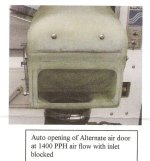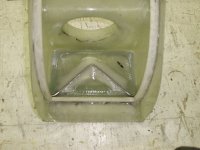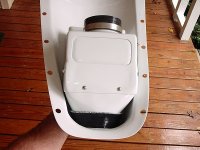Great recommendation. When my incident happened, I got all sorts of advice, including install another plug and go fly. After two days of looking for the cause, I decided to start my annual condition inspection early. It wasn't until I removed the FAB and the 1/4 bolt dropped on the floor that I found the cause.My takeaway from this is:
1. Inspect things that can fall off and get sucked in on condition inspections.
2. If a plug electrode is damaged suddenly, stop running the engine until the source of the debris is found.
Van's Air Force
You are using an out of date browser. It may not display this or other websites correctly.
You should upgrade or use an alternative browser.
You should upgrade or use an alternative browser.
Multiple Spark plugs damaged
- Thread starter Kevin M
- Start date
The installation instructions for all models specify rivets, and bedding the flange to the air box / snorkel with a flox mixture to assure it will never move and to prevent failure of the rivets.PS: on the 14, this door ring is riveted to the intake plenum. Probably a better approach for this reason.
The reason the induction by-pass was introduced was a fatal accident from loss of engine power in cruise flight, in snowy conditions.My biggest fear is sucking up a plastic grocery bag on take off. Ice aloft I can deal with in glider mode. engine dying at 100 AGL has low survivability. My recommendation is that every plane should have one. No different than someone removing a fire ext from the plane due to the risk of it coming off its mount and hitting the pilot in turbulence. Nothing is risk free, and we must weigh the pros and cons.
Safe flight is all about risk mitigation and this particular flight may not have been doing well in that regard, but if a bypass had been installed and used the outcome may have been very different.
Last edited:
Carb air doors and such have caused 2 crash's and one lucky escape. That I know of . 2 TBM avengers crashed in N.B while bud worm spraying when the carb air door failed and blocked the intake. At a ground school a warbird pilot related how a engine failed on take off in a P51 . The tail was up and accelerating when the engine quite cold . The pilot says he almost hit the lights on both sides of the runway with all that power coming off , the pilots watching says he kept it straight and got on the brakes with out digging the prop and stopped it with a few feet to spare. Carb air door blocked intake some how. As Bill says inspect things carefully on inspections , I have seen some scary ones.
hgerhardt
Well Known Member
Back to OP's original problem with smashed spark plugs: @drill_and_buck already asked but got no traction, so I'll ask it again:
How much inspection is appropriate here? Any possibility of cracks in the pistons? Or combustion chamber castings? I'd spend more than a few minutes with a borescope at a minimum, in ALL of the cylinders. If leakdown numbers are still good (and that's a good test to do too), I wouldn't worry too much about the valves, but inspecting the seats for dents is worth doing too.
How much inspection is appropriate here? Any possibility of cracks in the pistons? Or combustion chamber castings? I'd spend more than a few minutes with a borescope at a minimum, in ALL of the cylinders. If leakdown numbers are still good (and that's a good test to do too), I wouldn't worry too much about the valves, but inspecting the seats for dents is worth doing too.
It's possible to build an alternate air or carb heat door with limited hardware to escape into the intake tract. This one is built around a single length of hard music wire. The ends extend through the sides of the box. The bulk of the wire is floxed into the back of the door, under a few plies of glass. Fundamentally the wire and door are one part.
One end is bent to form an arm. An external spring attached to the arm keeps the door closed. The spring rate and arm length set the deltaP necessary to open the door in the event the filter or intake is blocked. This photo was taken by Don Rivera, with the Superflow bench at 1400 PPH air flow. With the inlet or filter blocked, carb loss increases from 5.0" H20 to 6.2' H20, and it goes 6.2% richer. It would also be taking air from the lower cowl volume, another slight power loss. I think the loss is a reasonable trade in return for no pilot action required. It's automatic.
BTW, there is a microswitch by the spring arm. If the door opens, it trips a flashing LED in the cockpit. Never has. It stays shut becasue it opens inward, and in normal operation, pressure inside the airbox is higher than lower cowl pressure. Doesn't leak either, because it was molded in place.



One end is bent to form an arm. An external spring attached to the arm keeps the door closed. The spring rate and arm length set the deltaP necessary to open the door in the event the filter or intake is blocked. This photo was taken by Don Rivera, with the Superflow bench at 1400 PPH air flow. With the inlet or filter blocked, carb loss increases from 5.0" H20 to 6.2' H20, and it goes 6.2% richer. It would also be taking air from the lower cowl volume, another slight power loss. I think the loss is a reasonable trade in return for no pilot action required. It's automatic.
BTW, there is a microswitch by the spring arm. If the door opens, it trips a flashing LED in the cockpit. Never has. It stays shut becasue it opens inward, and in normal operation, pressure inside the airbox is higher than lower cowl pressure. Doesn't leak either, because it was molded in place.



Last edited:
It was difficult to do a thorough inspection with a borescope. I was working with an A&PIA on this issue and after much deliberation we decided to remove the cylinder so we could thoroughly inspect it on the bench.Back to OP's original problem with smashed spark plugs: @drill_and_buck already asked but got no traction, so I'll ask it again:
How much inspection is appropriate here? Any possibility of cracks in the pistons? Or combustion chamber castings? I'd spend more than a few minutes with a borescope at a minimum, in ALL of the cylinders. If leakdown numbers are still good (and that's a good test to do too), I wouldn't worry too much about the valves, but inspecting the seats for dents is worth doing too.
I gotta say, the design and construction of the alt air mechanism reminds me of my erector set as a kid. Very crude design.... with enormous potential consequences. None of them good...This is one of the reasons I don't like seeing alt air doors on Carb engines. The risk/reward ratio is off.
A) effort & time to put in the door
B) Typical carb equipped certified planes don't have a door
C) anything that departs the door can (confirmed!) go up the engine. When hard objects go up the engine bad things can happen. A shorted spark plug being one of the least bad.
To be fair, what's the reward? Well, maybe if you take a lot of wet snow? So, engage carb heat BEFORE and make the carb heat door seal properly in the on position. Maybe you take a bird, fod, etc. and it plugs the chin inlet? With alt air you need to recognize and pull the actuator. With carb heat, same, but there's a possible chance the FOD has also blocked the carb heat. There is the risk.
Plus the doors leak and so you don't get as much positive air pressure from the ram system.
And they open up letting dirt into the engine.
So my contrary vote is: don't throw more money at it. Get rid of it.
Can you imagine your dentist handing you new fillings or crowns and saying " just go home and glue these in place. Don't worry if one dislodges in your sleep."
So I have to second the advice here..... get rid of it. Or buy the better designed product shown above at a minimum. Best of luck and reflect on dodging a bullet this time.
The issue may not have ever occurred if the original builder had installed the bypass in accordance with the instructions ( it wasn’t even close).I gotta say, the design and construction of the alt air mechanism reminds me of my erector set as a kid. Very crude design.... with enormous potential consequences. None of them good...
Can you imagine your dentist handing you new fillings or crowns and saying " just go home and glue these in place. Don't worry if one dislodges in your sleep."
So I have to second the advice here..... get rid of it. Or buy the better designed product shown above at a minimum. Best of luck and reflect on dodging a bullet this time.




